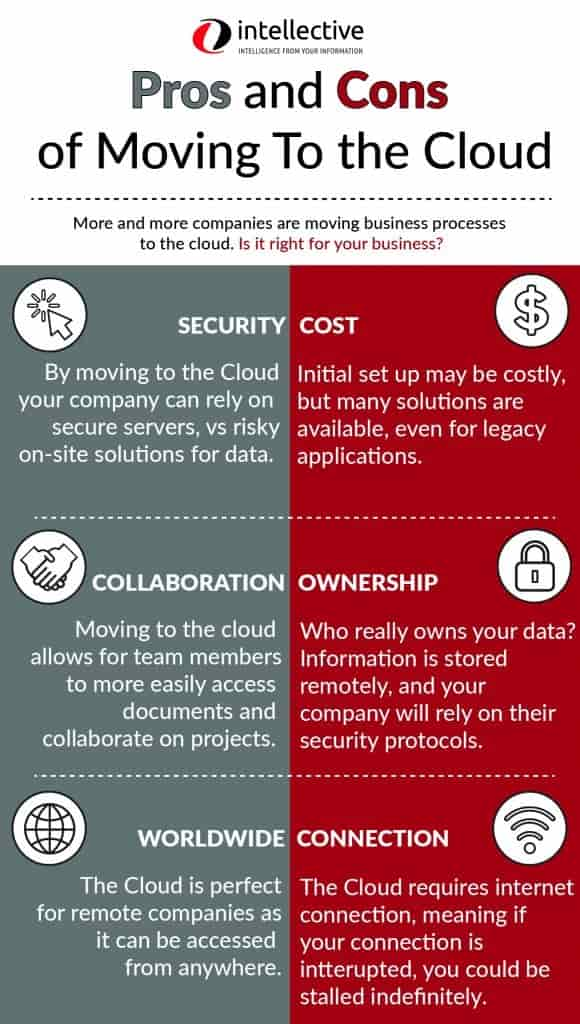In the last five years, the Cloud-based option has replaced traditional on-site enterprise solutions. Systems like CRM, ERP, ECM, IT Service Management, project management have all been moving to the Cloud.
The Upside of Moving to the Cloud
Why are so many companies moving processes to the Cloud? First and foremost, businesses can reduce risks by leveraging large reliable virtual networks instead of relying on riskier on-site solutions. With the advancements in technology the cost of entry is becoming lower, along with more standard tool sets that are easier to customize and upgrade. Thus, making the Cloud not only more accessible, but more user-friendly than it has been in the past.
In addition, having resources in the Cloud promotes collaboration amongst the workforce, with many companies tracking who interacts with different data sources. And because the Cloud is entirely virtual, it is easily accessible from anywhere in the world, making it a great resource for the growing number of remote-based companies.
Downsides of Moving to the Cloud
No solution is 100% perfect; including introducing the Cloud to your business operations. Out of the box, many Cloud solutions will still not match your current processes. This means you will have to engage in some level of customization and all the costs associated with it. Many times, organizations have conducted zero planning for required customization. They assumed the solution would work out of the box; there is no budge for customizations or
Another rarely considered downside of moving to the cloud, is the issue of who owns your company data, content, or workflow history. What happens when you change Cloud solutions? Essentially you are allowing another company to control your data and content. Do you trust that your Cloud provider is taking the same care as your company would in concerns to security and governance? What Happens when you want to change solutions?
Finally, while the upfront costs are lower, over the long term, many SaaS Cloud-Based solutions are more expensive than on-site enterprise systems. There is a reason Software companies are excited about SaaS cloud-based sales. It’s not because they are making less money selling SaaS Cloud-Based Solutions.

Common Pitfalls
While SaaS-Based Cloud solutions can be easier to install, configure, and support than highly customized “On-Premises” solutions, they are also less tuned to the needs of an organization requiring more process and culture transformation.
Insufficiently staffing your implementation project team can lead to issues. Even though Cloud solutions are virtual, they still need seasoned internal advocates for their success. The switch to Cloud can often be confusing, so initial buy-in is vital from the top down in a company. This will also directly change the structure of your company and how it runs. How will information be tracked and found? Will this increase or decrease the time it takes for employees to find what they need? How long will the onboarding process take? These are all critical factors to consider before the transition begins.
Another common issue is starting with default implementations in your Cloud solution. Just because it’s the default way of doing things, does not mean it will work for your company. You must consider your business processes and best practices. Then, using this information, you can decide what your company and employees really need and what will just be unnecessary. Additionally, keep in mind when transitioning that replicating old processes and procedures from your older system will not likely work. You have created a new environment, and because of this, most things will change.
What Can You do?
Plan logistically and strategically: Ensure your organization and partner teams are aligned, expectations are clear, resources are adequately estimated and allocated, program structures are effective, and teams are engaged and adequately trained.
Spend time on business processes: While implementation vendors typically bring best practices for system configuration and workflow, don’t get locked into something that doesn’t fit your business needs. Business process design and cross-functional team engagement is a key factor in defining better ways of doing things with your new tools. Don’t just replicate what you have done in the past; take advantage of the change to improve your business processes.
Involve your people early: Driving change throughout an organization requires a thoughtful and thorough approach across all disciplines of change management leadership, learning, communication, and organizational landscape.
